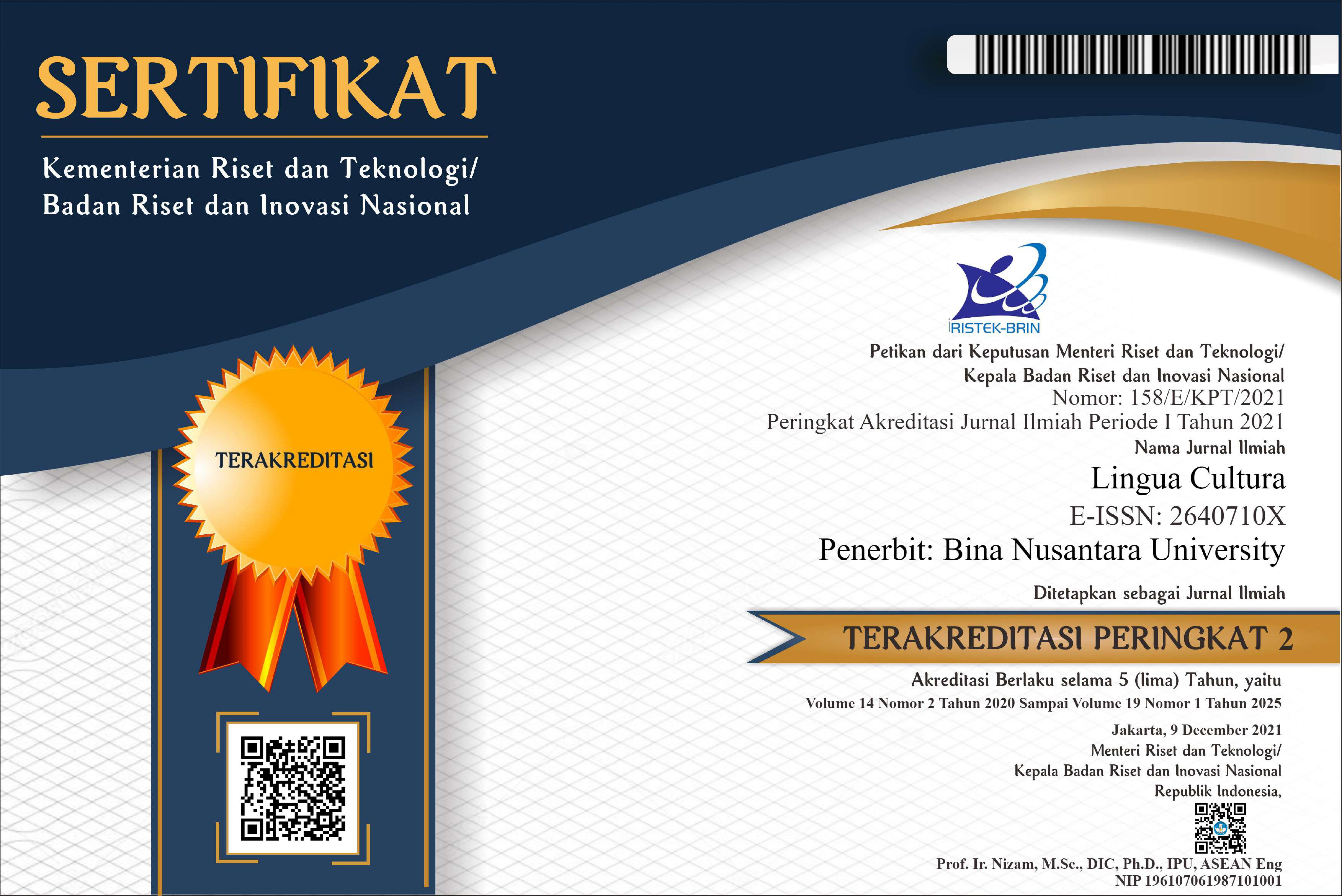The Correlation between Internet Literacy and Passive Vocabulary Size
DOI:
https://doi.org/10.21512/lc.v12i4.4113Keywords:
internet literacy, passive vocabulary, vocabulary sizeAbstract
This research aimed at describing the correlation between students’ internet literacy and their passive vocabulary size. The findings of this research were expected to predict how much the two variables correlate. This research was beneficial as inter internet users in Indonesia were growing in numbers (55 billion users in 2011), and most of them were students. Their intensity in using internet would affect on education, later. Thus, it was important to see whether there was a strong positive correlation between students’ internet literacy and their passive vocabulary size. Passive vocabulary became the limitation of this research as it could explain how big students’ ‘vocabulary reservoir,’ and thus, it could predict the active vocabulary size.
This was a correlational research involving randomly 81 senior students of English Education Department. The instruments used were a set of vocabulary test, and a questionnaire on internet literacy. Using two-tailed significant level, it is found that the result of rho is -0,001 with 0,993 of significant level. Therefore, there is no correlation between students’ internet literacy and their passive vocabulary size. It can be concluded that there are other factors which affect students’ passive vocabulary.
Plum Analytics
References
Abidin, M. J. Z., Pour-Mohammadi, M., Shoar, N. S., Cheong, S. T. H., & Jafre, A. M. (2011). A comparative study of using multimedia annotation and printed textual glossary in learning vocabulary.
International Journal of Learning and Development, 1(1), 82-90. https://doi.org/10.5296/ijld.v1i1.1070.
Adegoke, S. P., & Osokoya, M. M. (2015). Socio-economic background and access to internet as correlates of students achievement in agricultural science. International Journal of Evaluation and Research in Education (IJERE), 4(1), 16-21.
Ahmadi, M. R., Ismail, H. N., & Abdullah, M. K. K. (2012). Improving vocabulary learning in foreign language learning through reciprocal teaching strategy. International Journal of Learning and Development, 2(6), 186-201. https://doi.org/10.5296/ijld.
v2i6.2882.
Alemi, M., & Lari, Z. (2012). SMS vocabulary learning: A tool to promote reading comprehension in L2. International Journal of Linguistics, 4(4), 275–287. https://doi.org/10.5296/ijl.v4i4.2318.
Almumen, H. A. (2015). IPad apps’ influence on students’ compliance. International Journal of Education, 7(2), 51-66. https://doi.org/10.5296/ije.v7i2.7235.
Ary, D., Jacobs, L. C., Sorensen, C., & Razavieh, A. (2010). Introduction to Research in Education (8th Ed). Belmont, California: Wadsworth.
Bataineh, A. M. (2014). The effect of electronic dictionaries and hypermedia annotations on English major students’ reading comprehension and vocabulary learning. International Journal of Linguistics, 6(4), 102-115. https://doi.org/10.5296/ijl.v6i4.6025.
Davoudi, M., & Chavosh, M. (2016). Vocabulary learning strategy use by Iranian EFL learners across proficiency levels. International Journal of Linguistics, 8(1), 67-81. https://doi.org/10.5296/ijl.
v8i1.9032.
Koizumi, R., & In’nami, Y. (2013). Vocabulary knowledge and speaking proficiency among second language learners from novice to intermediate levels. Journal of Language Teaching and Research, 4(5), 900-913. https://doi.org/10.4304/jltr.4.5.900-913.
McCorkindale, T. (2010). Can you see the writing on my wall? A content analysis of the fortune 50’s facebook social networking sites. Public Relations Journal, 4(3), 1–14. https://doi.org/10.1017/
CBO9781107415324.004.
Mokhtar, A. A., Rawian, R. M., & Fauzee, M. S. O. (2013). The role of dictionary strategy in passive vocabulary knowledge acquisition of net generation students. Journal for the Study of English Linguistics, 1(1), 8-20. https://doi.org/10.5296/jsel.v1i1.4444.
Tess, P. A. (2013). The role of social media in higher education classes (real and virtual)-A literature review. Computers in Human Behavior, 29(5), A60–A68. https://doi.org/10.1016/j.chb.2012.12.032.
Walker, A., & White, G. (2013). Technology enhanced language learning: Connecting theory and practice. Oxford: Oxford University.
Wulandari, T. D. (2013). The needs of internet literacy in an ongoing process of economic stability. Jurnal Ilmu Komunikasi, 10(1), 49-62.
Liu, Y. (2010). Social media tools as a learning resource. Journal of Educational Technology Development and Exchange, 3(1), 101-114. https://doi.org/Article.
Downloads
Published
Issue
Section
License
Authors who publish with this journal agree to the following terms:
a. Authors retain copyright and grant the journal right of first publication with the work simultaneously licensed under a Creative Commons Attribution License - Share Alike that allows others to share the work with an acknowledgment of the work's authorship and initial publication in this journal.
b. Authors are able to enter into separate, additional contractual arrangements for the non-exclusive distribution of the journal's published version of the work (e.g., post it to an institutional repository or publish it in a book), with an acknowledgment of its initial publication in this journal.
c. Authors are permitted and encouraged to post their work online (e.g., in institutional repositories or on their website) prior to and during the submission process, as it can lead to productive exchanges, as well as earlier and greater citation of published work.
USER RIGHTS
All articles published Open Access will be immediately and permanently free for everyone to read and download. We are continuously working with our author communities to select the best choice of license options, currently being defined for this journal as follows: Creative Commons Attribution-Share Alike (CC BY-SA)

















